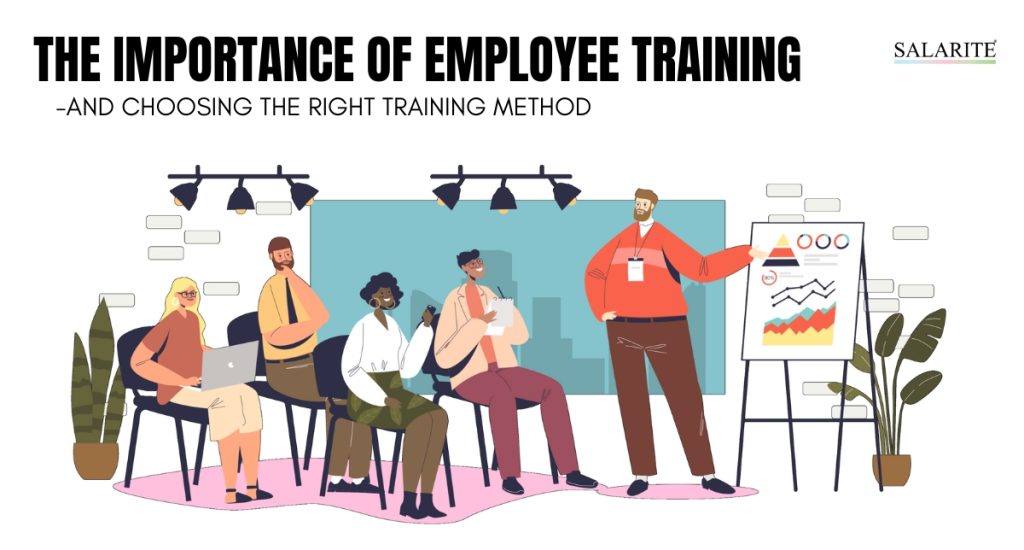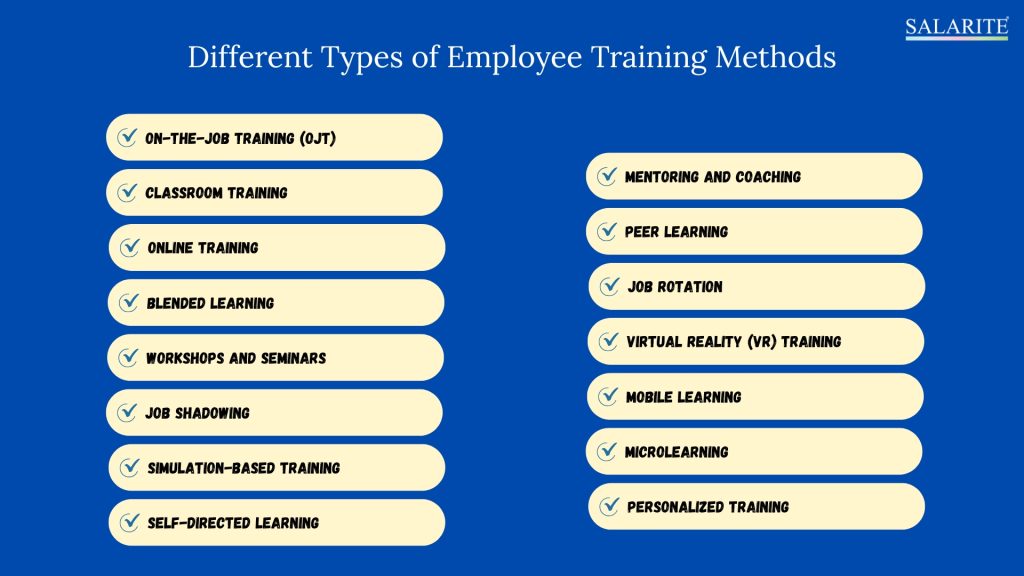
In today’s competitive business world, employee training is more than just an HR task—it’s essential for success. Companies which dedicate themselves to employee growth maintain flexible and innovative operations that allow them to outperform competitors. Whether you’re running a small business or a large company with jobs in Jaipur or across India, investing in the right corporate training is key to long-term success.
Companies need to conduct regular system updates because the changing technology landscape demands improved training for their workforce. The correct training enhances productivity while simultaneously improving staff satisfaction therefore leading to better talent retention. Let’s take a closer look at why employee training is so important and how to choose the best training methods.
Benefits of Employee Training

1. Increased Productivity
Productivity enhancements stem from training because employees gain enhanced abilities alongside specialized work knowledge. Expert staff members utilize their enhanced abilities to execute jobs more accurately while being more efficient thus delivering better results and speeding up work completion. Employees will maintain higher productivity when provided with upgraded tools, methods, and processes because they make fewer errors and need less support from others. Business operations run optimally because of a well-functioning workforce and organizations dedicate their resources toward executing strategic growth targets.
2. Skill Development
Industries moving forward together with technological progress makes continuous skill development more essential than ever. Training programs enable employees to prepare for existing challenges and upcoming ones because they develop essential skills needed to stay successful in their work. Organizations that train their employees for skill enhancement better respond to market changes thus developing agility alongside market resilience.
3. Employee Retention
Organizations which dedicate resources to employee development through extensive training ensure better retention of top talent. The ability to offer professional development opportunities makes employees feel respected which directly enhances their job satisfaction. The likelihood of employee job search decreases when organizations provide professional development opportunities. Employee commitment to staying long-term improves when they see advancement opportunities inside their organization. Organizations dedicate time and resources to employee training programs to maintain their workforce stability while lowering both employee turnover and recruitment costs and enhancing employee expertise.
4. Company Culture Enhancement
Training is instrumental in shaping and enhancing a company’s culture. By providing employees with opportunities to learn and grow together, companies promote collaboration, open communication, and mutual respect. Training initiatives, particularly those centered on leadership, diversity, and conflict management, strengthen common values and promote a constructive workplace atmosphere. A robust organizational culture fosters a united team that resonates with the company’s objectives, leading to a more driven and harmonious workforce dedicated to achieving success for the organization.
5. Improved Employee Morale
Employees who receive training and development opportunities feel more confident in their abilities and more connected to their roles. When employers invest in their employees’ growth, it boosts job satisfaction, morale, and overall happiness at work. Employees who are well-trained understand that they possess the necessary resources to thrive, and this feeling of achievement enhances their commitment and involvement with the organization. High morale also cultivates a more robust team environment, encouraging employees to work together, embrace challenges, and play a role in the company’s success.
6. Reduced Errors and Accidents
Training is essential for minimizing errors and safety incidents in the workplace. By educating employees on optimal practices, safety measures, and industry benchmarks, companies can guarantee that their workforce is well-prepared to prevent expensive errors and incidents. Well-trained staff understand how to operate machinery, adhere to protocols, and comply with regulations, thereby minimizing risks and fostering a safer workplace. This, in turn, leads to fewer disruptions in business operations, lower insurance costs, and enhanced employee well-being.
7. Increased Employee Engagement
Engaged employees are emotionally invested in their roles and the company’s goals. Training plays a vital role in enhancing engagement by offering employees the opportunity to learn new skills, take on challenges, and grow in their careers. A well-trained workforce is more likely to be motivated, enthusiastic, and committed to the success of the organization. By providing learning opportunities that align with their interests and career goals, companies can foster a workforce that is proactive, engaged, and driven to contribute to organizational growth.
8. Improved Customer Satisfaction
Trained employees are better equipped to handle customer interactions and provide exceptional service. Whether responding to inquiries, resolving complaints, or addressing customer needs, well-trained employees have the skills and knowledge to ensure that customers receive the best possible experience. When employees are confident in their abilities, they can resolve issues more efficiently, provide accurate information, and exceed customer expectations. This leads to improved customer satisfaction, loyalty, and a stronger brand reputation in the marketplace.
9. Higher Profitability
A well-trained workforce has a direct impact on a company’s bottom line. Skilled employees perform their tasks more efficiently, innovate faster, and contribute to better overall performance, which leads to higher profitability. Training also reduces errors, enhances customer service, and promotes innovation—all of which have a direct impact on revenue generation and cost management. As companies become more efficient and effective in their operations, they can increase output, reduce waste, and ultimately boost their profitability.
10. Fostering Innovation
Training fosters creativity and problem-solving among employees. By exposing employees to new ideas, tools, and perspectives, organizations can encourage innovative thinking and continuous improvement. Employees who are trained to think critically, challenge the status quo, and approach problems with new solutions are more likely to contribute innovative ideas. Whether it’s streamlining processes or introducing new products, an investment in training encourages a culture of innovation that drives business growth and keeps the company competitive in the marketplace.
11. Succession Planning
Training is essential for developing future leaders within an organization. By identifying high-potential employees and providing them with the necessary skills and experiences, companies can ensure a smooth leadership transition when needed. Training programs focused on leadership development, decision-making, and strategic thinking prepare employees to take on greater responsibilities and step into leadership roles. This supports long-term business continuity and reduces the risk of leadership gaps that can disrupt operations.
12. Talent Attraction and Retention
Talent Attraction
A company that invests in employee training stands out as an attractive employer. Potential candidates are drawn to organizations that prioritize growth and development opportunities. Offering comprehensive training programs showcases the company’s commitment to nurturing talent, making it easier to recruit top-tier candidates. Whether you’re seeking employees for jobs in Jaipur or expanding globally, having a strong training program in place helps position your organization as an employer of choice, ensuring that you attract skilled individuals eager to grow within your company.
Retention
Retention is significantly influenced by an organization’s commitment to employee development. Employees who feel they are continually learning and advancing are more likely to stay with the company long-term. Training programs not only improve job satisfaction but also provide employees with the opportunity to advance within the organization. When employees see a clear career path and feel supported in their growth, they are more likely to remain loyal, reducing the high costs associated with turnover and recruitment.
👉 Start Hiring—Free Job Posts on Salarite! Take advantage of our limited-time offer: post your first two job openings for free! Attract qualified candidates and build your perfect team with ease.
How to Choose the Right Training Method

1. Assessing the Learning Needs
Before implementing any employee training program, it’s crucial to conduct a skill gap analysis. This helps identify the areas where employees need improvement to meet current job demands or future challenges. Whether it’s mastering new technology or improving soft skills, understanding these gaps enables organizations to design targeted, effective training that delivers tangible results and helps employees thrive in their roles.
2. Consider Employee Preferences
Employees have diverse learning styles—some are visual learners, others auditory, and some prefer hands-on, kinesthetic experiences. By tailoring training methods to suit these preferences, organizations can improve the effectiveness of the program. When employees are engaged in the learning process, they retain information better and apply new knowledge more effectively, making training a more valuable investment.
3. Aligning with Organizational Goals
Training should align with the broader goals of the organization. Whether you’re aiming to improve customer service, adopt new technologies, or expand into new regions like openings in Jaipur, Rajasthan, training initiatives should support these objectives. This ensures that employees not only enhance their personal skills but also contribute directly to the company’s strategic direction, creating a more cohesive and motivated workforce.
4. Know Your Audience
Understanding the demographics, skills, and current knowledge levels of your employees is essential for effective training. Different teams or job roles may require specialized training programs. Knowing your audience allows you to tailor content to their needs, ensuring relevance and engagement. A personalized approach helps in addressing specific learning needs, maximizing the training’s impact, and driving higher performance across diverse teams.
5. Consider Training Duration
The duration of training plays a significant role in its effectiveness. Training sessions that are too short may not provide enough depth, while overly long sessions can lead to fatigue and disengagement. Striking the right balance ensures that employees receive sufficient time to absorb the material without feeling overwhelmed. It’s essential to design training programs that fit into employees’ schedules while delivering valuable, digestible content.
6. Continuous Feedback and Adaptation
Training programs should be dynamic, not static. Gathering feedback from employees during and after the training ensures that content is engaging and relevant. Regularly reviewing and adapting the training material based on this feedback helps improve future programs, address emerging skills gaps, and ensure that the training continues to meet both employee and organizational needs effectively.
Different Types of Employee Training Methods

1. On-the-Job Training (OJT)
On-the-job training allows employees to learn while working in their actual job environment. This method is cost-effective and highly practical, as employees gain real-time experience using tools and processes they’ll use daily. It promotes immediate application of skills and helps new hires adapt quickly. OJT is ideal for roles that require hands-on experience and learning by doing.
2. Classroom Training
Classroom training involves structured sessions led by an instructor in a physical or virtual classroom. It’s great for teaching theoretical concepts or when many employees need the same training. Participants can ask questions, join discussions, and get immediate clarification. This method is useful for introducing policies, compliance rules, or industry regulations in a consistent and controlled way.
3. Online Training
Online training provides flexibility through digital platforms, allowing employees to learn at their own pace, anytime and anywhere. It’s especially helpful for remote teams or companies managing jobs in Jaipur or across multiple locations. With videos, quizzes, and interactive modules, e-learning can cover a wide range of topics effectively. It also enables easy progress tracking and consistent content delivery.
4. Blended Learning
Blended learning combines the best of both online and in-person training. It offers the flexibility of e-learning along with the engagement of face-to-face interaction. Employees can study theoretical parts online and then attend workshops or sessions for practical application. This method supports different learning styles and improves retention through repeated exposure and active participation.
5. Workshops and Seminars
Workshops and seminars are short-term training events focused on specific topics or skills. These sessions are interactive and hands-on, often led by industry experts. Employees can practice new techniques, ask questions, and collaborate with peers. They are ideal for skill upgrades, motivational training, or introducing new tools and processes in a short period.
6. Job Shadowing
In job shadowing, an employee observes a senior or experienced colleague during their workday. It helps the learner understand daily tasks, workflows, and industry-specific practices. This method is useful for onboarding new employees or preparing team members for a new role. It also builds stronger workplace relationships and provides informal, yet impactful, learning opportunities.
7. Simulation-Based Training
Simulation training uses virtual environments to mimic real-world scenarios. It’s highly effective in industries like healthcare, aviation, or manufacturing, where employees must make quick, accurate decisions in high-pressure situations. This method allows learners to practice without real-world risks, improving confidence, decision-making, and performance in critical tasks.
8. Self-Directed Learning
Self-directed learning puts the responsibility on employees to manage their own development. Companies provide access to resources such as videos, reading materials, or online courses, and employees choose what and when to learn. This method encourages lifelong learning, self-discipline, and personalized growth based on each employee’s pace and career goals.
9. Mentoring and Coaching
Mentoring and coaching involve one-on-one guidance from experienced professionals. Mentors offer career advice, while coaches focus on improving specific skills or performance. This personalized approach helps employees gain confidence, leadership qualities, and deep insights into their roles. It also builds trust, encourages feedback, and supports long-term employee development.
10. Peer Learning
Peer learning allows employees to share knowledge through team projects, discussions, or collaborative tasks. It fosters a culture of learning and trust while leveraging the strengths of different team members. This informal yet effective method boosts engagement, improves communication, and promotes a sense of ownership among employees.
11. Job Rotation
Job rotation involves moving employees between different roles or departments to broaden their skills and understanding of the business. It enhances flexibility, prevents job monotony, and prepares employees for future leadership roles. This method also helps in succession planning and creates a more agile and capable workforce.
12. Virtual Reality (VR) Training
VR training offers an immersive learning experience using virtual reality headsets. It’s ideal for technical or high-risk jobs where real-world training could be dangerous or expensive. VR allows employees to safely practice procedures, understand complex environments, and improve hands-on skills in a simulated setting that feels real and engaging.
13. Mobile Learning
Mobile learning delivers training content through smartphones and tablets, making it easy for employees to learn on the go. It’s ideal for field workers, remote staff, or those with busy schedules. Content is often bite-sized, interactive, and available 24/7, which improves accessibility and encourages continuous learning.
14. Microlearning
Microlearning breaks training into short, focused sessions that cover specific topics or skills. These quick lessons are easier to understand and remember, making them ideal for busy employees. Delivered through videos, quizzes, or infographics, microlearning supports just-in-time learning and reinforces concepts over time for better retention.
15. Personalized Training
Personalized training is tailored to fit individual employee needs, goals, and learning styles. It often includes customized content, flexible pacing, and one-on-one guidance. This approach increases relevance, engagement, and impact, as employees receive support directly aligned with their roles and career development paths.
Also read: 🔑 Want to improve your recruitment strategy? Learn how to tackle hiring difficulties and attract skilled candidates efficiently.
How to Measure the Effectiveness of Employee Training
1. Feedback and Surveys
Collecting feedback and surveys after training helps assess employee satisfaction and the relevance of the training. It offers valuable insights into what worked well and what needs improvement, allowing companies to refine future programs for better effectiveness and engagement.
2. Tracking Performance Metrics
By monitoring key performance indicators (KPIs) like task completion time, work quality, and error rates, companies can measure the direct impact of training. Comparing performance before and after training reveals whether the program helped improve job efficiency and productivity.
3. Return on Investment (ROI)
Evaluating ROI involves comparing training expenses with the business benefits gained, such as higher productivity or increased sales. It helps determine if the training was cost-effective and supports data-driven decisions for future learning investments.
4. Employee Retention Rates
Tracking retention rates helps identify whether training contributes to employee satisfaction and loyalty. A positive correlation between training and lower turnover suggests that learning opportunities are enhancing employee engagement and reducing the cost of hiring new talent.
Conclusion
In an evolving business world, fostering a culture of continuous learning is vital. From skill development to succession planning, employee training is key to unlocking organizational potential. Whether you’re filling jobs in Jaipur, launching new initiatives, or scaling operations, robust employee training programs ensure your workforce remains skilled, motivated, and future-ready.
Take a proactive approach today—assess your current training initiatives, gather employee feedback, and choose the right training methods aligned with your company’s goals. An investment in your employees is an investment in your company’s success.
Salarite Helps You Hire Smarter with Pre-Trained Professionals
At Salarite, we understand that a company’s success depends on having a skilled and prepared workforce. That’s why we connect employers with pre-screened, job-ready candidates who are equipped with the right skills, industry knowledge, and a growth mindset. Whether you’re hiring in Jaipur or expanding across Rajasthan, our platform gives you access to professionals who can contribute effectively from day one.
By focusing on job readiness, we help employers reduce training costs, speed up onboarding, and improve employee retention. Our thorough screening and training processes ensure candidates align with your company culture and business goals. Partnering with Salarite means investing in long-term talent that drives productivity and growth. Let us help you build a smarter, stronger team quickly and efficiently, so you can focus on growing your business with confidence.
Ready to hire skilled professionals? Post a free job on Salarite and find the right talent faster.


